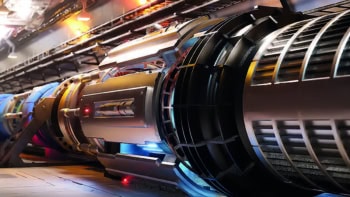The immense popularity of the Internet is threatening high-energy physics experiments, which need to transmit vast amounts of data around the world. What can particle physicists do to improve things?
Particle physics is a truly global activity, with literally hundreds of university departments around the world specializing in the subject. The basic tools of particle physics are a small number of powerful accelerators, which have led researchers over the last decade to develop what is known as the “Standard Model” of particle physics. The model describes essentially all of the subatomic phenomena that have been observed so far. However, there are compelling reasons for believing that new phenomena, which would provide the key to a much deeper understanding of the nature of matter, lie just beyond the energy range of existing facilities. The problem is that measuring particle behaviour at these higher energies requires increasingly complex apparatus. For example, the 14 TeV Large Hadron Collider (LHC) at CERN in Geneva, which is due to come on line in 2005, has attracted the interest of some 4000 scientists in 45 countries. High-energy physicists are therefore under pressure to spend time in the laboratory where their experiment will be carried out. They may need to be away for short spells to attend design meetings or to test or install equipment, and occasionally for longer periods to operate an experiment or to analyse results. Such absences, if too prolonged or too frequent, can eventually hinder their full participation at their own universities. They quite simply need to be in two places at the same time. To help to resolve this conflict, particle physicists have always used electronic communication (see Unfortunately the reality of the Internet today is that its performance on a given route – for example, between a physics institute in one country and an accelerator centre in another – can be highly variable (see So although there are many routes that perform acceptably during much of the day, there are some that are quite simply inadequate for today’s particle physicists. However, particle physicists know that they should be using the Internet more intensely. First, there is a major latent demand for more and better collaboration between small groups of researchers (say up to 10 people) who are working together on individual aspects of an experiment. This demand has not yet been fulfilled because the tools that are needed to collaborate in this way are only just becoming available. The other reason why high-energy physicists need to use the Internet more than ever before is the continuing growth in the volume of data recorded by particle physics experiments. For example, the LHC will generate about a thousand times as much data as its predecessor, the large electron-positron collider, which began operating in 1989. Apart from congestion on the Internet there is also the problem of cost. Although a few labs pay directly to optimize specific aspects of their Internet connections, most Internet services tend to be provided by national academic and research networks, which serve a much wider field than just particle physics. There is not much direct recharging for such services – which are normally funded by some combination of the research and education ministries and the national network organization – and research labs spend little of their own budget directly for networking. Another problem is that the cost of using the Internet varies greatly around the world. A 1994 report by Coopers and Lybrand for the European Commission showed that the prices for high-capacity international leased circuits, which form the basis of Internet connectivity, were almost eight times as high in Europe as in the US. While it is always possible to imagine that various efficiency issues could explain a factor of two in the range of costs, the factor of eight – which in my experience has been valid for much of the past 15 years – indicates that current European prices for Internet services are at an artificially high level because of a lack of competition in the market. This environment is now changing profoundly following European deregulation on 1 January 1998. Whenever I have tried to understand the economics of providing telecoms infrastructure, I have come to the conclusion that it must be an extremely profitable business. The pricing of Internet services obviously depends largely on the pricing of the underlying leased circuits. So when will we see effective competition to supply such circuits on an international basis inside Europe and around the world? The recent arrival of private investors (as opposed to the traditional consortia of telecoms suppliers) in the transatlantic cable market is one sign that things are starting to change. Meanwhile, in land-based communications, the arrival of competitors such as Worldcom could stimulate some of the other US and European telecoms vendors to provide access to their own pan-European infrastructures. If this happens, prices might fall quite quickly and still leave suppliers with very respectable profit margins. I believe that technological progress and increased competition should now quickly and strongly reduce the price and increase the quality of high-performance Internet services. However, there is no simple way to predict just when, in the next five years, the arrival of effective competition will really trigger this process, especially in Europe. We will just have to wait and see. One body that is attempting to tackle these problems is the International Committee for Future Accelerators (ICFA), which consists of about 20 senior academics and particle physicists. The committee recently created a new networking task-force to look at how particle physicists can get more out of the Internet, and several working groups are already active. One is trying to follow the performance of all of the many routes that we need to use on a regular and uniform basis. Another is making an inventory of the networks on which particle physics depends – particularly in developed countries – while a third group is doing the same exercise in remote regions. Later this year the task-force will recommend to ICFA how the networking of the next generation of particle physics experiments could be improved. Some people are concerned that the ICFA initiative might lead to the particle physics community deciding to do its own thing and to no longer depend on the general-purpose academic and research Internet. If this were to happen, runs the argument, particle physics would be seen to be responsible for destroying the consensus among the academic and research communities, which has driven much of the progress in international networking over the past few years. This concern is especially acute in Europe, where the introduction of the trans-European TEN-34 network last year, which has a capacity of 34 Mbit s-1, means that the Continent has, for the first time, international academic and research network services that compete favourably with those elsewhere in the world. I feel strongly that this fear is based on a false dilemma. Any research community needs to be able to measure the performance of its networking on a uniform and ongoing basis, as ICFA is doing. It should also be responsible for understanding how much it is being charged for networking, both directly and indirectly, and should make sure that its members understand those costs and use networking facilities responsibly. It is only right for communities continually to try to understand whether and how they could obtain the same or better networking services at lower costs. The success of particle physics depends strongly on networking, so we must be well informed about how this field will evolve during the period of rapid change that will come. However, we should not forget that most of our community is based in universities throughout the world, and it seems inconceivable to me that any viable long-term strategy that ICFA might decide on this year could be in any sense “independent” of what is done by the national academic and research networks. Of course, no-one expects networks to look the same in 10 years’ time as they do today, and the particle physics community may still need to invest directly in certain places where it has special needs, but we are truly part of the university community and share its needs, aspirations and concerns. Perhaps most important is that, if we look at how major industries have managed to achieve the lowest pricing for telecoms services (albeit often for traditional telecoms activities rather than for Internet services), it has been by forming large diverse consortia that then make large competitive purchases on an international basis. There seems to be an important lesson here, which I think both particle physics and all of the academic and research community should heed.Communication breakdown
Cost factors
Should particle physics go it alone?



